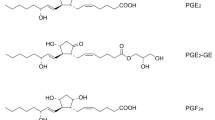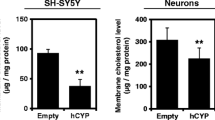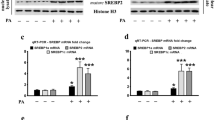Abstract
The brain shows high catalyzing activity during hydrolysis of long-chain acyl-CoAs into fatty acids and CoA-SH. Brain acyl-CoA hydrolase (BACH) is responsible for most of the long-chain acyl-CoA hydrolyzing activity in the brain and is localized exclusively in neurons. We analyzed the human BACH gene promoter, focusing on transcriptional regulation by Sterol Regulatory Element-Binding Protein-2 (SREBP-2), which is a transcription factor that activates genes involved in cholesterol biosynthesis and uptake. When the nuclear form of SREBP-2 gene was transfected into human neuroblastoma cells, transcription of a BACH gene promoter-luciferase reporter gene was activated through a sterol regulatory element (SRE) motif. Moreover, a gel shift assay demonstrated that SREBP-2 specifically bound to the SRE motif. These results suggest that transcription of the BACH gene is activated by SREBP-2. This study also provides insights into BACH function in the interaction between the metabolism of acyl-CoAs and cholesterol in neurons.
Similar content being viewed by others
References
Faergeman NJ, Knudsen J: Role of long-chain fatty acyl-CoA esters in the regulation of metabolism and in cell signalling. Biochem J. 323: 1–12, 1997
Waku K: Origins and fates of fatty acyl-CoA esters. Biochim Biophys Acta 1124: 101–111, 1992
Hunt MC, Alexson SE: The role Acyl-CoA thioesterases play in mediating intracellular lipid metabolism. Prog Lipid Res 41: 99–130, 2002
Anderson AD, Erwin VG: Brain acyl-coenzyme A hydrolase: Distribution, purification and properties. J Neurochem 18: 1179–1186, 1971
Katoh H, Kawashima Y, Watanuki H, Kozuka H, Isono H: Effects of clofibric acid and tiadenol on cytosolic long-chain acyl-CoA hydrolase and peroxisomal beta-oxidation in liver and extrahepatic tissues of rats. Biochim Biophys Acta 920: 171–179, 1987
Knauer TE: Factors affecting the activity and stability of the palmitoyl-coenzyme A hydrolase of rat brain. Biochem J. 179: 515–523, 1979
Lin AY, Sun GY, MacQuarrie R: Partial purification and properties of long-chain acyl-CoA hydrolase from rat brain cytosol. Neurochem Res. 9: 1571–1591, 1984
Broustas CG, Hajra AK: Purification, properties, and specificity of rat brain cytosolic fatty acyl coenzyme A hydrolase. J. Neurochem 64: 2345–2353, 1995
Kuramochi Y, Takagi-Sakuma M, Kitahara M, Emori R, Asaba Y, Sakaguchi R, Watanabe T, Kuroda J, Hiratsuka K, Nagae Y, Suga T, Yamada J: Characterization of mouse homolog of brain acyl-CoA hydrolase: Molecular cloning and neuronal localization. Brain Res Mol Brain Res 98: 81–92, 2002
Yamada J, Furihata T, Iida N, Watanabe T, Hosokawa M, Satoh T, Someya A, Nagaoka I, Suga T: Molecular cloning and expression of cDNAs encoding rat brain and liver cytosolic long-chain acyl-CoA hydrolases. Biochem Biophys Res Commun 232: 198–203, 1997
Yamada J, Kuramochi Y, Takagi M, Suga T: Expression of acyl-CoA hydrolase in the developing mouse brain. Neurosci Lett 355: 89–92, 2004
Yamada J, Kurata A, Hirata M, Taniguchi T, Takama H, Furihata T, Shiratori K, Iida N, Takagi-Sakuma M, Watanabe T, Kurosaki K, Endo T, Suga T: Purification, molecular cloning, and genomic organization of human brain long-chain acyl-CoA hydrolase. J Biochem (Tokyo) 126: 1013–1019, 1999
Yamada J, Kuramochi Y, Takagi M, Watanabe T, Suga T: Human brain acyl-CoA hydrolase isoforms encoded by a single gene. Biochem Biophys Res Commun 299: 49–56, 2002
Takagi M, Kawabe K, Suga T, Yamada J: A 50-kDa isoform of mouse brain acyl-CoA hydrolase: expression and molecular properties. Arch Biochem Biophys 429: 100–105, 2004
Brown MS, Goldstein JL: The SREBP pathway: regulation of cholesterol metabolism by proteolysis of a membrane-bound transcription factor. Cell 89: 331–340, 1997
Krieger M: Isolation of somatic cell mutants with defects in the endocytosis of low-density lipoprotein. Methods Enzymol 129: 227–237, 1986
Maruyama K, Sugano S: Oligo-capping: a simple method to replace the cap structure of eukaryotic mRNAs with oligoribonucleotides. Gene 138: 171–174, 1994
Lo K, Smale ST: Generality of a functional initiator consensus sequence. Gene 182: 13–22, 1996
Athanikar JN, Sanchez HB, Osborne TF: Promoter selective transcriptional synergy mediated by sterol regulatory element binding protein and Sp1: A critical role for the Btd domain of Sp1. Mol Cell Biol 17: 5193–5200, 1997
Sato R, Inoue J, Kawabe Y, Kodama T, Takano T, Maeda M: Sterol-dependent transcriptional regulation of sterol regulatory element-binding protein-2. J Biol Chem 271: 26461–26464, 1996
Yamada J, Furihata T, Tamura H, Watanabe T, Suga T: Long-chain acyl-CoA hydrolase from rat brain cytosol: Purification, characterization, and immunohistochemical localization. Arch Biochem Biophys 326: 106–114, 1996
Sato R, Miyamoto W, Inoue J, Terada T, Imanaka T, Maeda M: Sterol regulatory element-binding protein negatively regulates microsomal triglyceride transfer protein gene transcription. J Biol Chem 274: 24714–24720, 1999
del Castillo-Olivares A, Gil G: Differential effects of sterol regulatory binding proteins 1 and 2 on sterol 12 alpha-hydroxylase. SREBP-2 suppresses the sterol 12 alpha-hydroxylase promoter. J Biol Chem 277: 6750–6757, 2002
Shimomura I, Shimano H, Horton JD, Goldstein JL, Brown MS: Differential expression of exons 1a and 1c in mRNAs for sterol regulatory element binding protein-1 in human and mouse organs and cultured cells. J Clin Invest 99: 838–845, 1997
Hunt MC, Solaas K, Kase BF, Alexson SE: Characterization of an Acyl-CoA thioesterase that functions as a major regulator of peroxisomal lipid metabolism. J Biol Chem 277: 1128–1138, 2002
Edmond J, Robbins RA, Bergstrom JD, Cole RA, de Vellis J: Capacity for substrate utilization in oxidative metabolism by neurons, astrocytes, and oligodendrocytes from developing brain in primary culture. J Neurosci Res 18: 551–561, 1987
Takagi M, Yamakawa H, Watanabe T, Suga T, Junji Y: Inducible expression of long-chain acyl-CoA hydrolase gene in cell cultures. Mol Cell Biochem 252: 379–385, 2003
Thompson AL, Cooney GJ: Acyl-CoA inhibition of hexokinase in rat and human skeletal muscle is a potential mechanism of lipid-induced insulin resistance. Diabetes 49: 1761–1765, 2000
Boylan JG, Hamilton JA: Interactions of acyl-coenzyme A with phosphatidylcholine bilayers and serum albumin. Biochemistry 31: 557–567, 1992
Yanase H, Shimizu H, Yamada K, Iwanaga T: Cellular localization of the diazepam binding inhibitor in glial cells with special reference to its coexistence with brain-type fatty acid binding protein. Arch Histol Cytol 65: 27–36, 2002
Pfrieger FW: Outsourcing in the brain: Do neurons depend on cholesterol delivery by astrocytes? Bioessays 25: 72–78, 2003
Maloberti P, Mele PG, Neuman I, Cornejo Maciel F, Cano F, Bey P, Paz C, Podesta EJ: Regulation of arachidonic acid release in steroidogenesis: Role of a new acyl-CoA thioestrase (ARTISt). Endocr Res 26: 653–662, 2000
Puglielli L, Konopka G, Pack-Chung E, Ingano LA, Berezovska O, Hyman BT, Chang TY, Tanzi RE, Kovacs DM: Acyl-coenzyme A: Cholesterol acyltransferase modulates the generation of the amyloid beta-peptide. Nat Cell Biol 3: 905–912, 2001
Selkoe DJ: Translating cell biology into therapeutic advances in Alzheimer’s disease. Nature 399: A23–A31, 1999
Tanzi RE: A genetic dichotomy model for the inheritance of Alzheimer’s disease and common age-related disorders. J Clin Invest 104: 1175–1179, 1999
Chang TY, Chang CC, Cheng D: Acyl-coenzyme A: Cholesterol acyltransferase. Annu Rev Biochem 66: 613–638, 1997
Author information
Authors and Affiliations
Corresponding author
Rights and permissions
About this article
Cite this article
Takagi, M., Suto, F., Suga, T. et al. Sterol Regulatory Element-Binding Protein-2 modulates human brain acyl-CoA hydrolase gene transcription. Mol Cell Biochem 275, 199–206 (2005). https://doi.org/10.1007/s11010-005-1990-y
Received:
Accepted:
Issue Date:
DOI: https://doi.org/10.1007/s11010-005-1990-y




